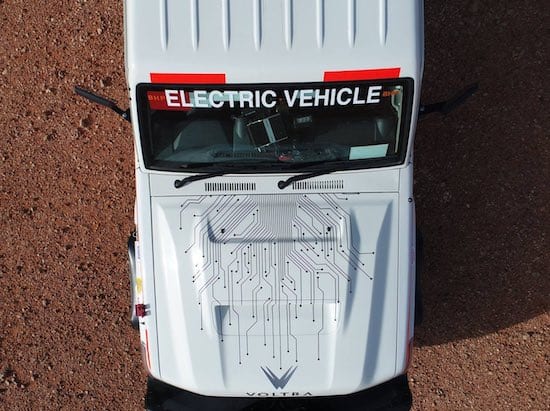
We know a lot of the world’s biggest mining and resources companies are turning to clean energy to power their remote and off-grid operations – and, more recently, their processing plants.
But what about their cars?
Australian mining giant BHP has announced that it is trialling electric vehicles – and not among its fleet of executive rides, but at the “coalface”, so to speak, of its massive Olympic Dam copper mine in South Australia.
The news was announced on the BHP website on Wednesday, as well as in a Facebook post that is attracting some predictably negative and skeptical public feedback – but that’s mostly because the company has done the unspeakable and converted a V8 4WD true blue Aussie ute to electric drive.
Yes, an electric ute. And in doing so, with the help of Adelaide-based Voltra, which adapted the vehicle, BHP has managed to beat Tesla to the punch, with Elon Musk only these past few weeks releasing a few clues about the next big project for the EV maker.
According to Voltra, the eCruiser is based on the Toyota LandCruiser 70 Series, “the most popular light vehicle in mining today,” and has been put through its paces (at a NZ wind farm, see image below) and “proven to survive the longest in rough, corrosive 4WD environments.”

Voltra says the electric motor driving the eCruiser is “relatively simple,” especially when compared to a diesel engine, which requires costly maintenance.
Like other EVs, the electric motor also acts as a regenerative brake, and the Voltra says the li-ion battery offers the necessary range, durability and efficient charging to make the eCruiser a reliable mining light vehicle.
As BHP’s Facebook post explains, the company’s very own adapted 4 x 4 Toyota LandCruiser ute – pictured above – arrived in Roxby Downs earlier this month, and has been undergoing final testing before it joins the 240-vehicle underground fleet in July.
A second adapted EV is expected to “join the fold” in coming months, the company says, with a decision on wider deployment at Olympic Dam expected to be made during in the coming financial year.
“While they may look similar to a traditional Land Cruiser or ute, our LEVs are at the heart of our work on low emissions technology,” BHP says.
“Powered by a lithium-ion battery, it will be monitored for performance, power supply, maintenance requirements, charging time and corrosion resistance underground.
“Importantly, as they are battery-powered, our team’s exposure to the diesel particular matter generated by traditional diesel engines is significantly reduced.”
This is a major concern for BHP, and its Olympic Dam site – with its team of around 800 underground employees – is as good a place as any to begin to address it.
Among its other environmental and sustainability targets, the company has set a goal to cut in half the number of employees with potential exposure to particulate matter, across all of its operations.
According to the World Health Organisation, diesel particulate matter is carcinogenic to the same degree as cigarette smoke and asbestos, and diesel machinery in underground mines presents some of the most severe exposures to this health hazard.
But the shift to electric powered vehicles is also about cutting costs. According to the Voltra website, a mining fleet using renewable energy could cut its total energy costs by 10-20 per cent compared to the cost of diesel fuel.
“Olympic Dam’s switch to LEVs in its operations will reduce emissions, exposure and costs – as well as influencing the rollout of similar initiatives in our other locations,” the company says.
BHP plans to share the data it collects from the trial across the company, to help accelerate the broader deployment of electric light vehicles.
“This is a really exciting project for BHP that has the potential to significantly reduce our emissions and improve working conditions for our people right across the globe, and we are especially proud that Olympic Dam is at the forefront,” the FB post says.
But, as noted above, some of the comments posted in response to the news tell the story of an Australia that is still a few-thousand kilmometres shy of embracing electric cars.
“Couldn’t see this lasting too long underground there, haha,” says one comment. Another: “this here is a Cruiser I don’t like;” and “V8 Cruisers deserve to have V8s in them.”
Sadly, such attitudes as these are nurtured – or at least, not discouraged – by the nation’s ICE car lobby, and some of its most senior politicians, either because they have a lot to lose from the shift to EVs, or because they are just hard-wired to reject any and all technological change.
We saw this in full force late last month, when Australia’s car industry lobby launched a major new kick-back against car emissions standards being vaguely proposed for light vehicles in Australia.
As we reported here, the Murdoch papers eagerly reported dire warnings from the Federal Chamber of Automotive Industries that an emissions standard – Australia is one of the world’s only OECD nations that does not have one – would take some of the nation’s highest selling cars out of the market, including those precious utes.
And Nationals senator John Williams vowed to resist any new standard that stopped rural and regional Australians from buying their vehicle of choice.
“This might be all well and good to save the planet in someone’s eyes, but to me an electric vehicle out on a station, on a farm, would be totally useless,” Williams told The Australian.
Looks like BHP didn’t get the memo.










